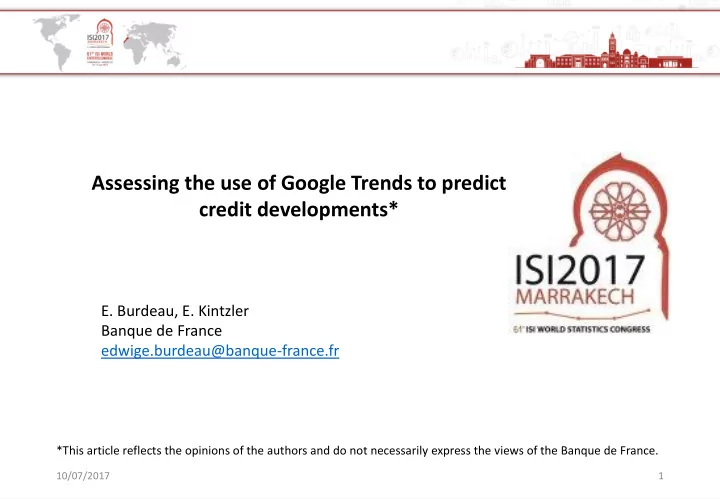

Assessing the use of Google Trends to predict credit developments* E. Burdeau, E. Kintzler Banque de France edwige.burdeau@banque-france.fr *This article reflects the opinions of the authors and do not necessarily express the views of the Banque de France. 10/07/2017 1
Motivation Net credit flows for house purchase, narrowly defined effective rate of new contracts of credit for house purchase and ECB deposit facility rate 12 7 6 10 5 8 4 6 3 4 2 2 1 0 0 -2 -1 janv.-04 juin-04 nov.-04 avr.-05 sept.-05 févr.-06 juil.-06 déc.-06 mai-07 oct.-07 mars-08 août-08 janv.-09 juin-09 nov.-09 avr.-10 sept.-10 févr.-11 juil.-11 déc.-11 mai-12 oct.-12 mars-13 août-13 janv.-14 juin-14 nov.-14 avr.-15 sept.-15 févr.-16 juil.-16 déc.-16 Net credit flows for house purchase (seasonnally adjusted, in Bn € , l.h.s) New contracts of credit for house purchase, narrowly defined effective rate (in %, r.h.s) ECB key facility rate, deposit facility rate (in %, r.h.s) Sources: ECB, Banque de France
Google Trends, a widely used data source Contrary to official statistics, Google Trends are made available in near real time. A large part of the recent literature on forecasting has been devoted to the usefulness of Google Trends to catch the demand side of the economy : We identified more than 50 articles published since 2009 (without being exhaustive!) From different fields , from finance to macroeconomics, especially on the housing sector: Nowcasting and forecasting of home sales, house prices, mortgage delinquency, building permits … Generally relying on “simple” models such as autoregressive models augmented with Google Trends indicators, with some exceptions. 10/07/2017 3
Our approach Forecasts from 0 to 3 months in advance of housing indicators: credit flows for house purchase ; With different explanatory indicators from Google Trends, we tried: to define a generic approach with Google Correlate to identify appropriate indicators, to identify “robust” indicators , by using principal component analysis. Relying on different variable selection models , from the recent “machine learning” literature , both linear and non-linear models.
Google Correlate – Automated query selection In two ways: By uploading external time series on credit for house purchase, Google Correlate returns the most highly correlated Google Trends and, We selected manually 12 indicators, containing names of French credit institutions. By giving a prespecified individual Google query (“credit for house purchase”), Google Correlate returns the 100 queries the most highly correlated, We retained the first 5 principal components of this set of indicators. Set of potential explanatory variables: 17 variables from Google Trends + the 3 lagged terms of the endogenous variable. 10/07/2017 5
Google Trends carry leading information on credit flows Evolutions of credit flows for house purchase and the second principal component of the 100 correlates related to lending for house purchase 5 4 3 2 1 0 -1 -2 -3 Jan-04 Jan-05 Jan-06 Jan-07 Jan-08 Jan-09 Jan-10 Jan-11 Jan-12 Jan-13 Jan-14 Jan-15 Jan-16 Jan-17 Net credit flows for house purchase (seasonnally adjusted, standardized) New contracts of lending for house purchase (seasonnally adjusted, standardized) Second principal component of the 100 correlates of the term "lending for house purchase" (seasonnally adjusted, standardized) Sources: Banque de France, Google Trends 10/07/2017 6
A set of machine learning models have been tested Different variable selection models to curb the noise of irrelevant preselected indicators: Penalized linear models (LASSO and Elastic net): parameters of irrelevant variables are shrunk towards zero ; L 2 Boosting approach : an iterative approach in which only relevant variables are selected ; Bayesian model averaging : posterior probabilities of models containing irrelevant variables are low ; A first experiment of a non-linear approach, called support vector machine , relying on a kernel approach (without variable selection). 10/07/2017 7
Google Trends indicators help forecasting credit flows several months in advance Gain in RMSE compared to the AR model, in function of the number of months in advance forecasts are estimated Forecasts of net credit flows for house purchase Forecasts of new contracts for house purchase 10% 25% 20% 5% 15% 0% 10% -5% 5% -10% 0% 3 2 1 0 3 2 1 0 LASSO Boosting LASSO Boosting BMA SVM BMA SVM 10/07/2017 8
Google Trends indicators help forecasting credit flows several months in advance Comparisons between net credit flows for house purchase and out-of-sample forecasts 3- months in advance for different type of models 8 7 6 5 4 3 2 1 0 -1 Net credit flows for house purchase (seasonnally adjusted, in Bn € ) Forecasts 3 months in advance, AR model Forecasts 3 months in advance, LASSO Forecasts 3 months in advance, SVM 10/07/2017 9
Way forward Using both Google Trends and Google Correlate can significantly improve medium-term forecasts. We identified a good leading indicator of credit flows for house purchase : the second principal component built with the 100 correlates of the term “lending for house purchase” . But, a frequency approach could confirm that Google Trends indicators are more appropriate to identify medium-term cycles. First experiment of a nonlinear approach is conclusive, Other models, such as neural networks, should be tested. 10/07/2017 10
Recommend
More recommend